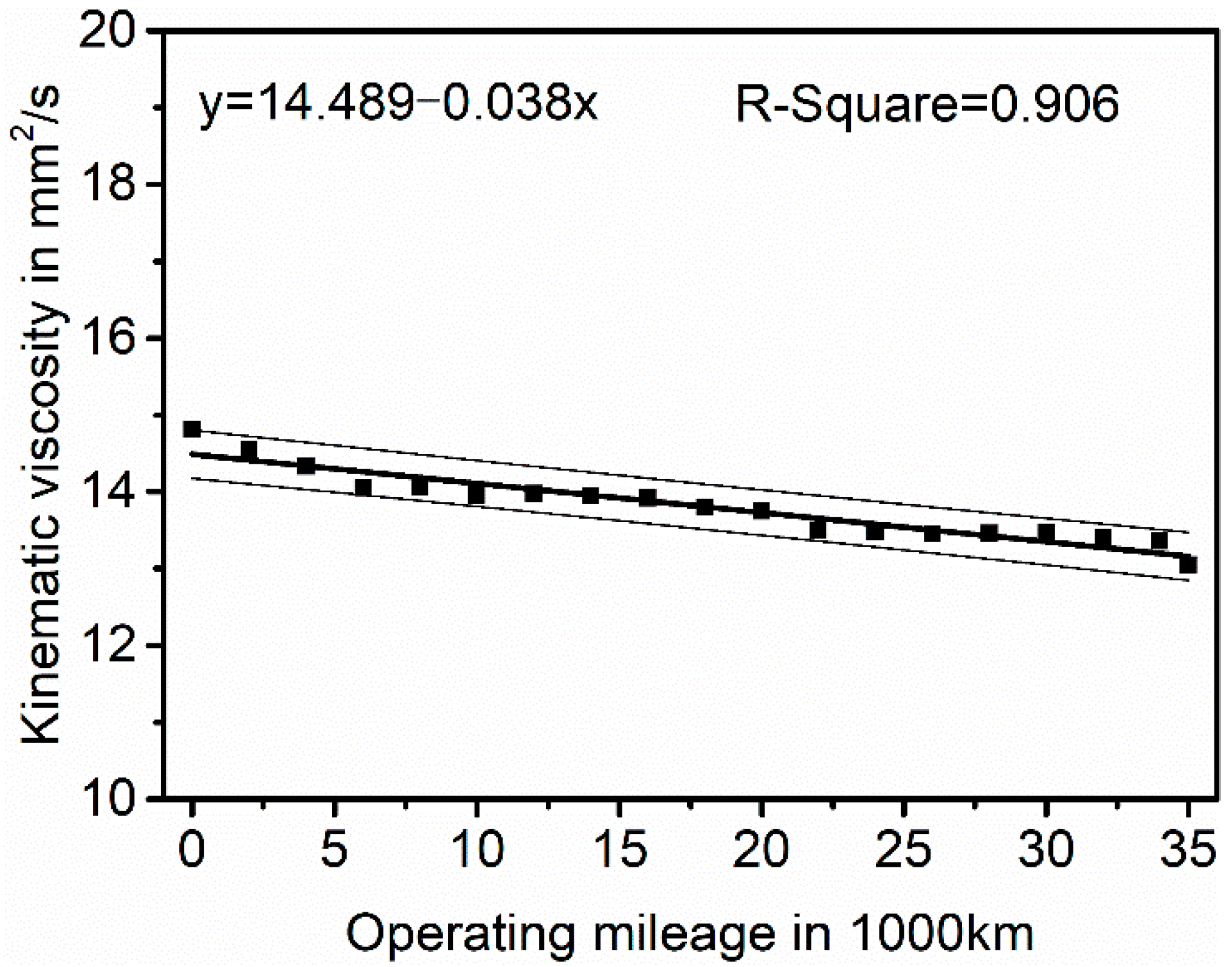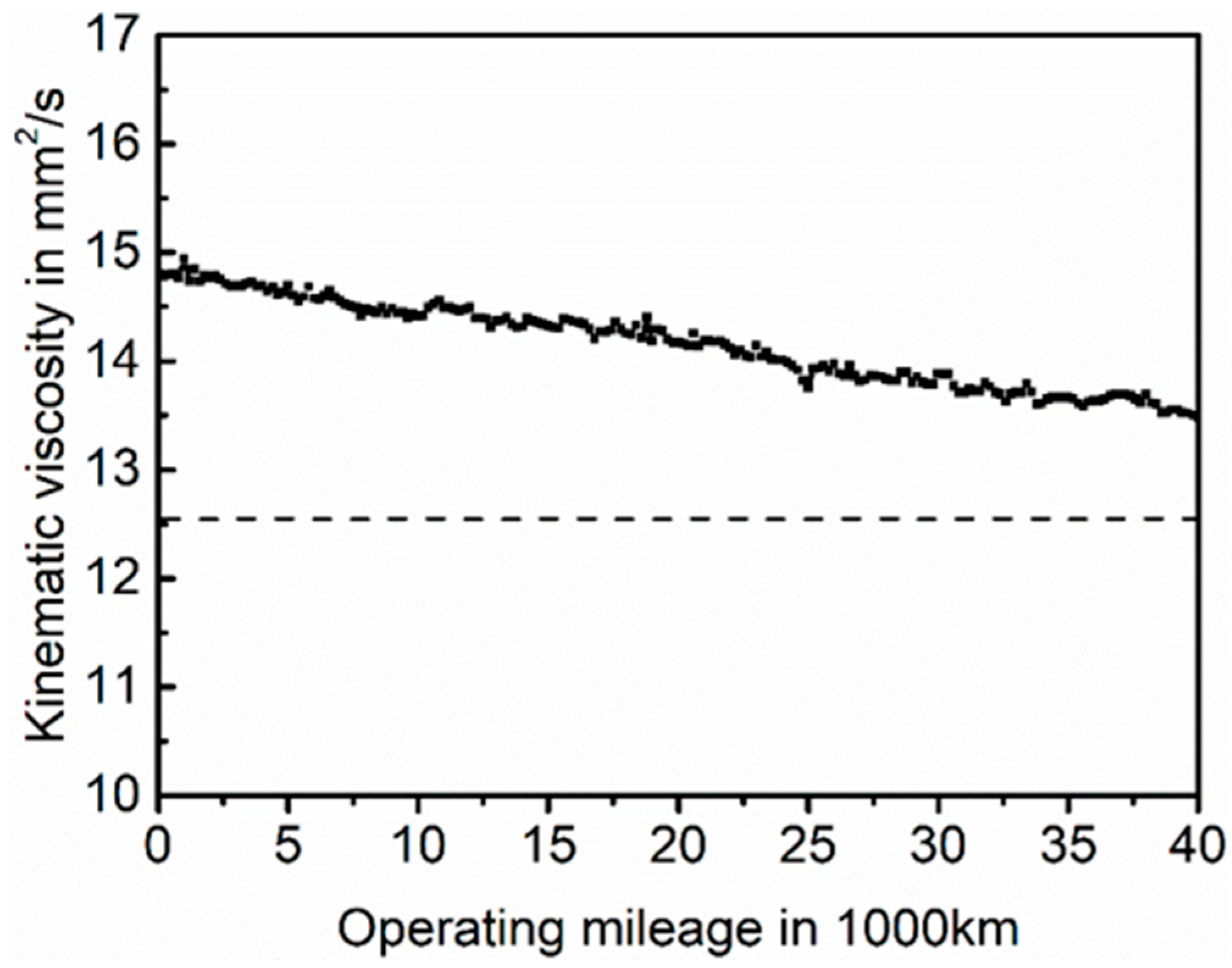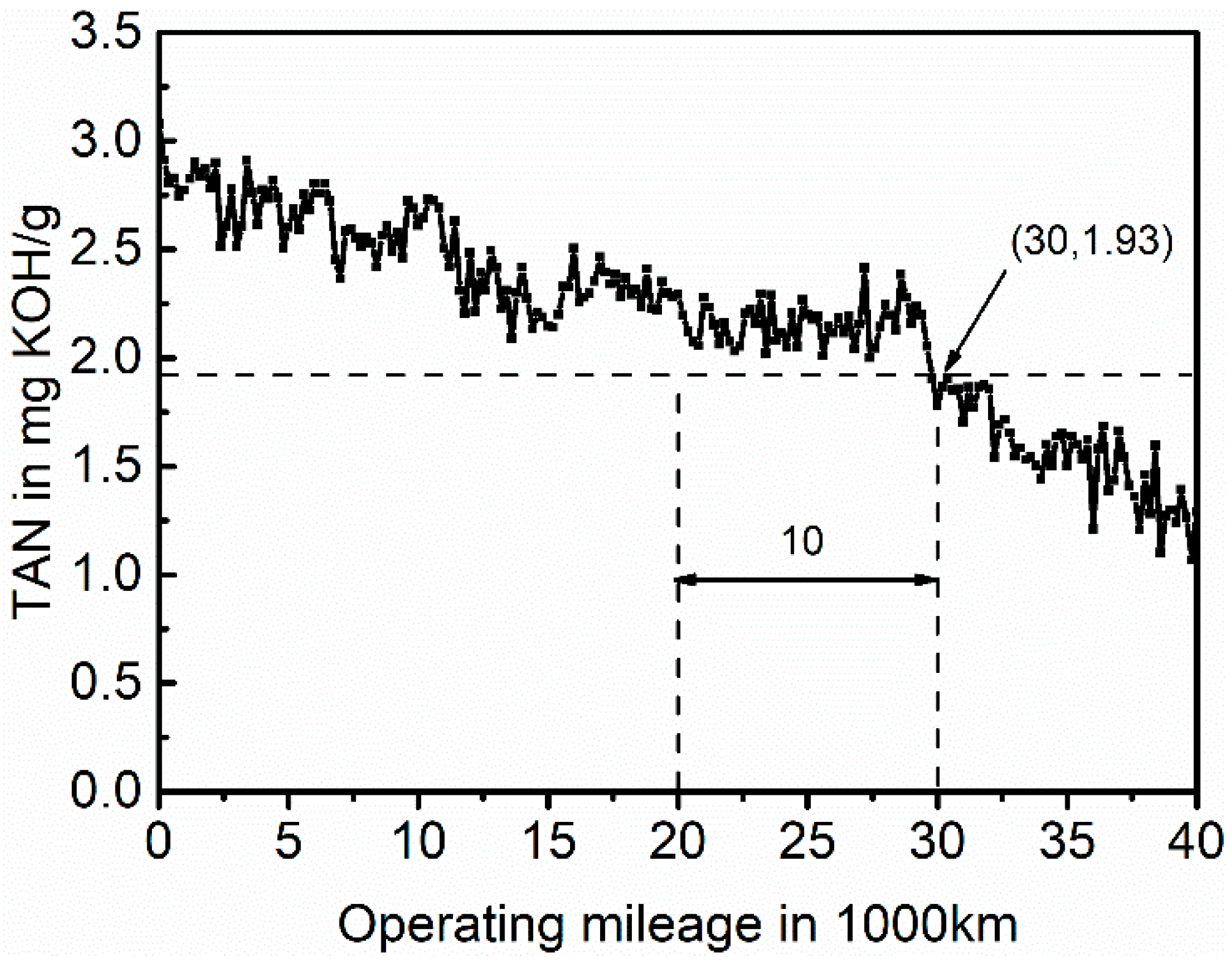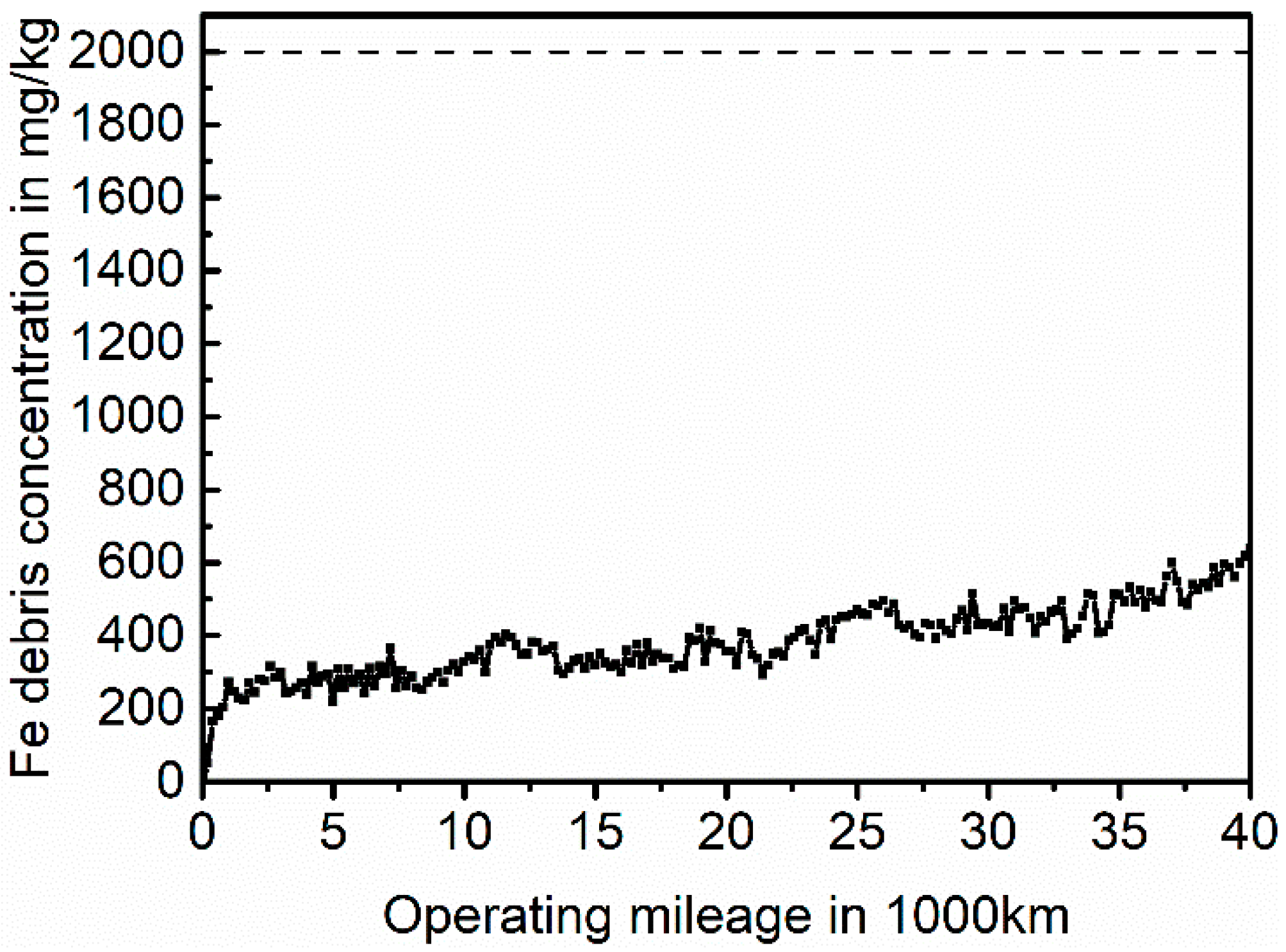Oil Change Interval Evaluation of Gearbox Used in Heavy-Duty Truck E-Axle with Oil Analysis Data
Abstract
:1. Introduction
2. Origin of the Oil Analysis Data
3. Regressive Analysis of the Oil Analysis Data
4. Wiener Process Modeling and Oil Change Interval Evaluation of Oil
4.1. The Wiener Process
- ;
- For of is a stationary and independent increment, which can be represented as an independent continuous random variable;
- For t > s > 0, the probability distribution function (PDF) of the increment is a standard Brownian movement that follows .
4.2. Oil Change Interval Evaluation
5. Conclusions
Author Contributions
Funding
Institutional Review Board Statement
Informed Consent Statement
Data Availability Statement
Conflicts of Interest
References
- Tung, S.C.; McMillan, M.L. Automotive tribology overview of current advances and challenges for the future. Tribol. Int. 2004, 37, 517–536. [Google Scholar] [CrossRef]
- Yan, S.; Ma, B.; Zheng, C. Degradation index construction methodology for mechanical transmission based on fusion of multispectral oil data. Ind. Lubr. Tribol. 2018, 72, 271–283. [Google Scholar] [CrossRef]
- Tung, S.C.; Woydt, M.; Shah, R. Global insights on future trends of hybrid/EV driveline lubrication and thermal management. Front. Mech. Eng. 2020, 6, 571786. [Google Scholar] [CrossRef]
- Zhou, F.; Yang, K.; Li, D.; Shi, X. Acid Number Prediction Model of Lubricating Oil Based on Mid-Infrared Spectroscopy. Lubricants 2022, 10, 205. [Google Scholar] [CrossRef]
- Hönig, V.; Procházka, P.; Obergruber, M.; Kučerová, V.; Mejstřík, P.; Macků, J.; Bouček, J. Determination of Tractor engine oil change interval based on material properties. Materials 2020, 13, 5403. [Google Scholar] [CrossRef]
- Yan, S.; Ma, B.; Zheng, C.; Chen, J. An optimal lubrication oil replacement method based on selected oil field data. IEEE Access 2019, 7, 92110–92118. [Google Scholar] [CrossRef]
- Khaleghei, A.; Makis, V. Reliability estimation of a system subject to condition monitoring with two dependent failure modes. IIE Trans. 2016, 48, 1058–1071. [Google Scholar] [CrossRef]
- Ma, B.; Yan, S.; Wang, X.; Chen, J.; Zheng, C. Similarity-based failure threshold determination for system residual life prediction. Eksploat. Niezawodn. 2020, 22, 520–529. [Google Scholar] [CrossRef]
- Yan, S.F.; Ma, B.; Zheng, C.S.; Chen, M. Weighted evidential fusion method for fault diagnosis of mechanical transmission based on oil analysis data. Int. J. Automot. Technol. 2019, 20, 989–996. [Google Scholar] [CrossRef]
- Yan, S.F.; Ma, B.; Zheng, C.S. Condition-based maintenance for power-shift steering transmission based on oil spectral analysis. Spectrosc. Spect. Anal. 2019, 39, 3470–3474. [Google Scholar] [CrossRef]
- Lijesh, K.P.; Muzakkir, S.M.; Hirani, H. Experimental tribological performance evaluation of nano lubricant using multi-walled carbon nano-tubes (MWCNT). Int. J. Appl. Eng. Res. 2015, 10, 14543–14550. [Google Scholar]
- Yan, S.F.; Ma, B.; Zheng, C.S. Remaining useful life prediction for power-shift steering transmission based on fusion of multiple oil spectra. Adv. Mech. Eng. 2018, 10. [Google Scholar] [CrossRef] [Green Version]
- Yan, S.F.; Ma, B.; Zheng, C.S.; Zhu, L.A.; Chen, J.W.; Li, H.Z. Remaining useful life prediction of power-shift steering transmission based on uncertain oil spectral data. Spectrosc. Spect. Anal. 2019, 39, 553–558. [Google Scholar] [CrossRef]
- Du, Y.; Duan, C.; Wu, T. Replacement scheme for lubricating oil based on Bayesian control chart. IEEE Trans. Instrum. Meas. 2020, 70, 1–10. [Google Scholar] [CrossRef]
- Tanwar, M.; Raghavan, N. Lubricating Oil remaining useful life prediction using multi-output Gaussian Process regression. IEEE Access 2020, 8, 128897–128907. [Google Scholar] [CrossRef]
- Wakiru, J.M.; Pintelon, L.; Muchiri, P.N.; Chemweno, P.K. A review on lubricant condition monitoring information analysis for maintenance decision support. Mech. Syst. Signal. Pract. 2019, 118, 108–132. [Google Scholar] [CrossRef]
- Kumar, P.; Hirani, H.; Agrawal, A.K. Online condition monitoring of misaligned meshing gears using wear debris and oil quality sensors. Ind. Lubr. Tribol. 2018, 70, 645–655. [Google Scholar] [CrossRef]
- Kumar, P.; Hirani, H.; Agrawal, A.K. Effect of gear misalignment on contact area: Theoretical and experimental studies. Measurement 2019, 132, 359–368. [Google Scholar] [CrossRef]
- Zheng, C.; Liu, P.; Liu, Y.; Zhang, Z. Oil-based maintenance interval optimization for power-shift steering transmission. Adv. Mech. Eng. 2018, 10. [Google Scholar] [CrossRef] [Green Version]
- Yan, S.; Ma, B.; Zheng, C. A unified system residual life prediction method based on selected tribodiagnostic data. IEEE Access 2019, 7, 44087–44096. [Google Scholar] [CrossRef]
- GB/T 30034-2013; GL-5 Gear Oil Change Index for Heavy Duty Vehicles. Standards Press of China: Beijing, China, 2013.
- Du, Y.; Wu, T.; Makis, V. Parameter estimation and remaining useful life prediction of lubricating oil with HMM. Wear 2017, 376, 1227–1233. [Google Scholar] [CrossRef]
- Liu, Y.; Ma, B.; Zheng, C.; Xie, Y. Failure prediction of power-shift steering transmission based on oil spectral analysis with wiener process. Spectrosc. Spect. Anal. 2015, 35, 2620–2624. [Google Scholar] [CrossRef]
- Makis, V.; Wu, J.; Gao, Y. An application of DPCA to oil data for CBM modeling. Eur. J. Oper. Res. 2006, 174, 112–123. [Google Scholar] [CrossRef]
- Aslam, M. Performance of Kibria’s method for the heteroscedastic ridge regression model: Some Monte Carlo evidence. Commun. Stat.-Simul. Comput. 2014, 43, 673–686. [Google Scholar] [CrossRef]
- Wang, D.; Tsui, K.L. Brownian motion with adaptive drift for remaining useful life prediction: Revisited. Mech. Syst. Signal. Pract. 2018, 99, 691–701. [Google Scholar] [CrossRef]
- Mao, X.; Sabanis, S. Numerical solutions of stochastic differential delay equations under local Lipschitz condition. J. Appl. Math. Comput. 2003, 151, 215–227. [Google Scholar] [CrossRef] [Green Version]
- Itô, K. Multiple wiener integral. J. Math. Soc. Jpn. 1951, 3, 157–169. [Google Scholar] [CrossRef]
- Pecht, M.G. A prognostics and health management roadmap for information and electronics-rich systems. IEICE ESS Fundam. Rev. 2010, 3, 25–32. [Google Scholar] [CrossRef]







| Oil Change Indicator | Mean Value μ | Standard Deviation σ |
|---|---|---|
| kinematic viscosity at 100 °C | 13.81 | 0.43 |
| TAN | 2.20 | 0.52 |
| Fe debris concentration | 358.42 | 152.72 |
| Oil Change Indicator | Threshold | FHT (1000 km) | CBM Interval (1000 km) | PM Interval (1000 km) |
|---|---|---|---|---|
| kinematic viscosity at 100 °C | +10%–−15% | - | 30 | 20 |
| TAN | ±1 | 30 | ||
| Fe debris concentration | 2000 mg/kg | - |
Publisher’s Note: MDPI stays neutral with regard to jurisdictional claims in published maps and institutional affiliations. |
© 2022 by the authors. Licensee MDPI, Basel, Switzerland. This article is an open access article distributed under the terms and conditions of the Creative Commons Attribution (CC BY) license (https://creativecommons.org/licenses/by/4.0/).
Share and Cite
Yan, S.; Kong, Z.; Liu, H.; Li, B.; Fan, M.; Zhang, X. Oil Change Interval Evaluation of Gearbox Used in Heavy-Duty Truck E-Axle with Oil Analysis Data. Lubricants 2022, 10, 252. https://doi.org/10.3390/lubricants10100252
Yan S, Kong Z, Liu H, Li B, Fan M, Zhang X. Oil Change Interval Evaluation of Gearbox Used in Heavy-Duty Truck E-Axle with Oil Analysis Data. Lubricants. 2022; 10(10):252. https://doi.org/10.3390/lubricants10100252
Chicago/Turabian StyleYan, Shufa, Zhuo Kong, Hongwei Liu, Bin Li, Mao Fan, and Xiaokun Zhang. 2022. "Oil Change Interval Evaluation of Gearbox Used in Heavy-Duty Truck E-Axle with Oil Analysis Data" Lubricants 10, no. 10: 252. https://doi.org/10.3390/lubricants10100252
APA StyleYan, S., Kong, Z., Liu, H., Li, B., Fan, M., & Zhang, X. (2022). Oil Change Interval Evaluation of Gearbox Used in Heavy-Duty Truck E-Axle with Oil Analysis Data. Lubricants, 10(10), 252. https://doi.org/10.3390/lubricants10100252





